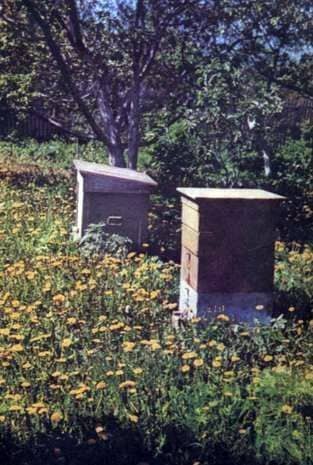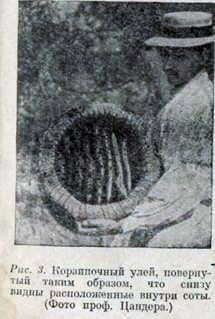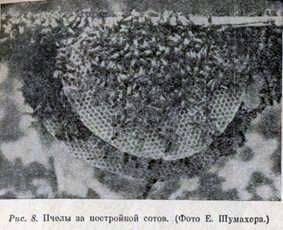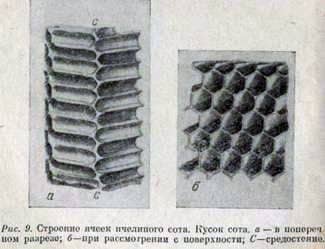Bee house


Fig. 5. Hive with bees. The roof is removed, one honeycomb in a wooden frame is taken out. L – a leaf on the front wall of the hive, in front of it – a landing board.
For each bee family, the beekeeper provides a wooden box – a beehive (see Figure 5). In the front wall of the hive there is a crevice, through which the bees exit and enter the hive. In the past, beekeepers used straw boxes (sapets) instead of wooden boxes, which are still used in many places.

The reader may ask: where did the bees live before the person turned them into pets? Although beekeeping is a very ancient industry – the Egyptians bred bees 5000 years ago, as we know from the images preserved in the temples and tombs – the bees themselves are much older, and until the person took on the care of them, they lived in a wild state.
Often it happens that the bee family flies away from the beekeeper and settles in the wood, in the hollow of a tree. This is the primitive dwelling of bees, and since in the old times there were more hollow trees than now in our modern, cultural forests, the bees did not lack a dwelling.

A tree, like a sapetka or a beehive, serves only as an external protection for bee housing; Inner buildings of a bee erect for themselves, building from the wax of a honeycomb.
Some beekeepers use a wooden deck under the bees’ dwelling, which is nothing but a piece of wood with a hollow.

Hives of this type are closest to the primitive bees’ dwelling: inside the sapetics a similar protected area is also formed. The advantage of these hives is that they are easier and more convenient to
However, the interior of all these old beehive dwellings is inaccessible to the beekeeper, and he can not interfere with the life of the bees. That’s why, when in the middle of the last century they decided to give bees as a dwelling a wooden box with a removable back wall and hang several wooden frames in which bees can build honeycombs inside, this was a great progress in beekeeping.
Now each individual honeycomb can be taken out with the frame from the hive, if necessary, inspect it, correct everything, and then put it back in the hive.
You can select individual honey-filled honeycombs and replace them with empty ones, without disturbing the family at the same time, whereas under the old system, honey production was associated with the destruction of buildings, and often with the destruction of the entire family. Therefore, hives with mobile honeycombs have become so widespread.
The fact that the bee dwelling can be moved entirely, gives the beekeeper another important advantage. The hollow of the tree, the primitive dwelling of the bees, is “tied” to the place, and the beekeeper can transport the box or baskets with bees to another locality, when at certain times of the year the melliferous plants in the area where the apiary is located begin to discolor.
Such nomadic beekeeping is an excellent means of increasing honey production in many localities. In the time that is poor in flowers, when the buckwheat fields and broad expanses of the marsel reveal for a few weeks innumerable millions of their full nectar flowers for bees, beekeepers come from everywhere and arrange beehives with bees (just as a peasant brings cattle to mountain meadows to use unfit for others pasture time).
The beekeeper provides bees with hives and wooden frames for detaching the honeycomb. And honeycombs build bees themselves. Yes, and the substance from which honeycombs are built, wax, they produce themselves. Each worker bee carries a “wax plant”.
This sounds somewhat unusual. Nevertheless, the separation of wax is by no means the privilege of bees-it is also observed in other insects. So, for example, in the summer you can often notice small white lumps, which are carried in the air like tiny snowflakes. If you catch them and consider, it turns out that these aphids (plant lice) wrapped in a kind of “fur” of the finest white wax threads, sweat through the pores of their skin. Wax, in its chemical composition resembling fat, bees are allocated by the underside of the abdomen.

Here, in the depth of the skin folds formed by the segments of the abdomen, it appears in the form of small thin scales. Instead of uselessly dropping these wax flakes, the bees remove them with their paws, crumple strong mandibles – a special device located near the mouth, rolled into a waxy lump and a patch behind the site is built from these lumps of honeycomb.

Construction in a beehive does not go on all the time, but, when necessary, it takes place very quickly. Fig. 8 shows how many small builders have time to make a night. The figure also shows that the construction of honeycomb is carried from the top down.
Each honeycomb consists of many thousands of wax chambers or cells that are used by the part as “children’s”, for growing babies (broods), and partly as pantries for folding feed reserves. They are arranged remarkably expediently. In Fig. 9, a is a honeycomb cut from top to bottom and across. It has a mediastinum (C), which, like the rest of the honeycomb, consists of wax and serves as a base for the cells located on both sides of it.

The base of each cell is deepened. The recesses of the cells of one side of the honeycomb for better utilization of the space are placed in the spaces between the recesses of the cells of the opposite side. The cells are slightly inclined, just enough so that they do not leak the reserves of semi-liquid honey. But the most remarkable thing is that the side walls of the cells form a hexagon.

Bees could, of course, from the very beginning build their cells with round walls, as bumblebees do, or with any other number of adjacent walls. However, with round or, say, eight or pentagonal cells, there would be an unused space between them (the figure is shown in dark). This would lead to an inefficient use of space: each cell would have to have its own walls in whole or in part, that is, it would take extra material.
With three, four or hexagonal cells, both these deficiencies fall away, since each wall is common to two neighboring cells and, thus, is used doubly, without forming any gaps. The triangles, four – and hexagons in Fig. 10 are shown in such a way that they exactly limit completely equal areas. The bee cells, whose cross section corresponds to these dimensions, will have the same amount of honey at the same depth, regardless of whether they are three-, four – or hexagonal.
However, hexagonal cells have the shortest length of sides of all three geometric shapes that are equal in area. Therefore, the construction of a hexagonal cell of equal capacity requires the least amount of building material. In addition, the round shape of the bee babe, for the cultivation of which many cells are intended, is much better adapted to the space bounded by a hexagon than to a quadrangular and the more triangular form of cells.
Thus, using a hexagonal shape to build a cell, the bees really found the best and most economical of all conceivable options. Scientists wrote a lot and talked about how the bees found it, but nobody could figure it out to the end.
We have already briefly mentioned the dual purpose of bee cells: they store food reserves and grow offspring. Now we turn to questions about the form and origin of food and the bee brood.
Bee house
